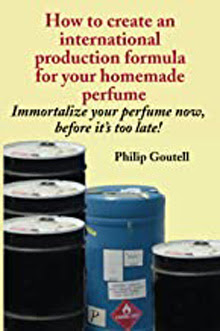
I knew I had done it when my wife started wearing it without being prompted. I knew I had done it when, in the late afternoon, I could still detect the clear aroma of the perfume she had put on that morning. I knew without a doubt that I had created a fragrance that (1) my wife liked well enough to USE without being prompted, (2) that had enough RADIANCE so that I could detect it on her from a distance, and (3) that it had enough TENACITY to last all day. I was even more gratified to learn that several of her friends had ASKED her what perfume she was wearing ... because they liked it too!
How much training does it take to create a successful perfume of your own, on your own? A number of people have asked me where I got my training in perfumery. The fact is that my "training" is quite limited and nothing that is not, today, available to anyone who wants it badly enough and who is willing to read, learn, spend a little money, and discipline themselves to think, smell, take notes, and keep at it.
It doesn't come by magic and it doesn't come overnight. But unless you get started and work at it, it will never come at all.
My starting point was DESIRE. The desire to LEARN how to create perfume. This much I knew: perfume or cologne is a mixture of alcohol and fragrance compound. The alcohol is plain ethyl alcohol, commonly denatured due to tax regulations and frequently sold under such names as "perfumer's alcohol" or some such. In the United States, the approved methods of "denaturing" alcohol are found at the Treasury Department's website. "SD-39" and "SD-40" are the common denatured formulas for the ethyl alcohol used in cosmetics and perfumery.
Once the alcohol and fragrance compound have been mixed and allowed to blend thoroughly, all that remains is to bottle and package your perfume or cologne.
As far as the perfume or cologne itself is concerned, the key to it all is the "juice" -- the fragrance compound to be mixed with the alcohol, and THIS is what perfumers create. This was what I wanted to learn how to create. Getting started was not easy.
For me, the beginning was books. I searched for any books I could find on perfume making. Some books along this line exist. The best are expensive and sometimes quite hard to find. And the books I found inspired me. But what was missing was A FOUNDATION because these books were all written for people with SOME background and experience in perfumery. The fundamentals -- the basics of perfume creation -- were missing from these professional books.
Moreover, while the books talked about many common aroma materials, they made no suggestions as to WHERE these materials might be obtained, particularly in small and affordable quantities.
Everything changed for me when I discovered the PerfumersWorld Foundation Course. Is this just a blatant plug for a commercial product? Yes, I sell it at my website. And yes, I'd like to sell many times more than we now sell. But "yes," also, this home study course is the ONLY course I know of that is available to ANYONE to get you started in a professional way toward becoming a professional perfumer.
Now let me scroll back to the perfume I was talking about at the beginning of this article. It's called "Code Name: 'Paris'" and what's special about it is that, with the exception of a trace of one single aroma material, ALL of the aroma materials that I used to create "Code Name: 'Paris'" are materials that are included with the PerfumersWorld Foundation Course.
For me, this home study course, which comes with aroma materials and supplies, was MY starting point in professional perfumery. Can YOU create your own perfume too? Hey, your nose may be a lot better than mine and YOU might go farther even faster!


